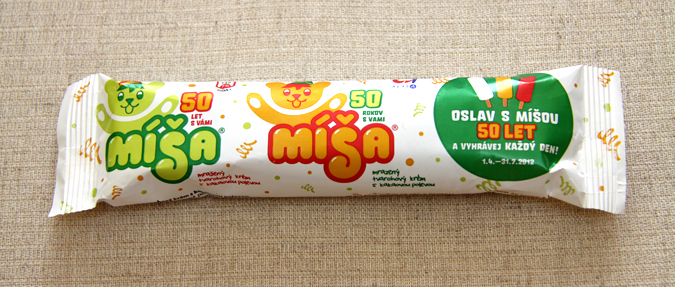What would be the Czech equivalent of ‘American as apple pie’? As Czech as… beer? Dumplings? The manufacturers of Míša – a quark-based ice cream – may well argue that their product is one of the nation’s identifying foods.
This year, Míša is celebrating its 50th anniversary. While the brand may be ‘middle-aged’, the packaging and overall image is one of eternal childhood. A teddy bear and bright colors mark the packaging, and inside is the same ice cream locals have enjoyed since the sixties.
PARTNER ARTICLE
If you’re not familiar with Míša, the notion of a quark-flavored confection might strike you as strange. Quark is, after all, a type of soft cheese, and cheese ice cream at best sounds like an oxymoron. Maybe the combination isn’t so strange. Czech cuisine, among others, uses quark in a number of desserts. It’s grated on the top of fruit dumplings, used to fill strudels, and is found in a popular dairy dessert. Perhaps it was only a matter of time before someone turned it into an ice cream.
Míša’s Beginnings
The time was exactly fifty years ago. Eva Marnounová, Ing., a food technologist, mixed quark with cream and sugar and froze it to see the result. Liking what she’d whipped up, Marnounová put her creation through a lengthy approval process in order to release the product. The committee in charge obviously found it to their liking, and in 1962 Míša went into production.
The early product was made entirely by hand. A team of 18 workers mixed the ingredients in sub-zero temperatures, managing about 1000 ice cream bars an hour. In 1973 the quark was made in a centrifuge, which improved its consistency and increased production. Around this time, Míša took on the shape for which it is known today. The chocolate coating was added as a means of preventing at least some of the treats running down a person’s hand as it melted.
Unfortunately, other details regarding the ice cream’s birth have not been recorded. Why did Marhounová decide to mix quark with cream and put it in the freezer in the first place? What was involved in the approval process, and why call it Míša, which apart from being the short form of Michaela , is the Czech word for a teddy bear? We contacted the company to get to the bottom of these mysteries. On their website is a quote from Marnouhová saying, “Ice cream, it was my hobby.” The rest they weren’t able to answer.
According the company, the ingredients have not changed. But the journalist Radka Hrdinová wonders if this is entirely true (in Czech). She thinks that there must have been some changes, but short of jumping in a time machine there is no way of knowing…unless someone out there has been saving the ice cream.
Continued Popularity
One thing which is not disputed is the continuing popularity of the ice cream. The Wikipedia entry for the treat claims the ice cream sells 12 million a year. This figure was not confirmed by the company, but they said that the ice cream does sell in the millions. According to surveys conducted for them, the brand is known by 97% of people in the Czech Republic.

In terms of overall popularity, there are a few online surveys of varying credibility. At iDnes, they recorded 63% of respondents saying they preferred Míša over other brands such as Ledňáček, Eskymo, Ruská zmrzlina, and foreign ice creams. In a much smaller survey, 74% of people said they preferred Míša to Mrož.
I suppose that the manufacturers of the ice cream would no doubt take these results – or at least those from the first survey – as proof of Míša’s appeal. The more dubious would point to the limited choice in both surveys and the small sample group of the second. Not to mention that the names are mentioned as opposed to asking people to say what their favorite is.
But the surveys show the presumption of popularity. Maybe people aren’t eating the ice cream all the time – and looking around me I can’t say I see it everywhere – but the brand and popularity go together. And, to be honest, it is the ice cream most people I know tend to have it in their freezer. Ruská zmrzlina comes in second, but maybe it’s just the people I know.
The Past Sells?
But why the longevity? One explanation could be the nostalgia. The company’s marketing material makes a lot of appeals to the past, especially the ice cream’s place in people’s memories. This approach can be quite powerful. It’s certainly worked for Kofola. Maybe nostalgia explains why all the former ice creams are popular but not why Míša is the most popular. It has to be something about the ice cream.
Hrdinová, in her article linked above, suggests that Czechs are conservative in their ice cream tastes and prefer the basic flavors, of which quark is one. While this character trait may explain the lasting appeal, it doesn’t explain how the ice cream came about. The flavor doesn’t appear to be found in other countries (though Hungary has a chocolate bar with a curd centre called Túró Rudi.) In a sense, Marhounová was taking a bit of a risk when she made it, and people were experimenting a bit when they first tried it.
Which means that Czechs must really like quark. As mentioned before, it does feature in a number of desserts, and they’re not entirely alone in their fondness for the soft mild cheese. If it is a case of just liking it, what accounts for that? I don’t know. Each nation has its tastes. Australians are fond of Vegemite.
Personally, I’ve got nothing against quark; I wouldn’t think of freezing it, but that’s just me. The ice cream is certainly tasty, and a little different from others on the market, but it’s hardly the first one I reach for. But it seems I’m in a minority.
Have you had a Míša? What do you think?
Related articles












 Reading time: 5 minutes
Reading time: 5 minutes 























